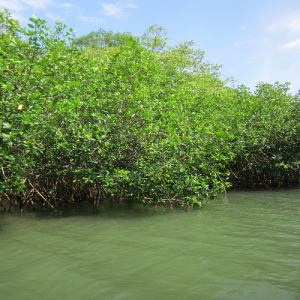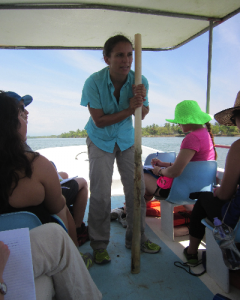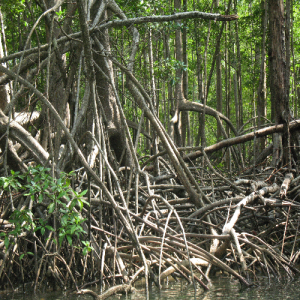Written by: Amy Huang
I had my first exposure to mangroves in high school when I took an AP Environmental Science class, but it was amazing to finally see how big they were in real life. It was such an interesting experience because we got to see the different types of seeds of each species of mangroves.
While in Costa Rica, we explored a mangrove swamp by boat to see the mangroves up close and personal. During the boat ride, we had a tour guide named Mila. Through her, we learned about the different species of mangroves and how each one plays a role in the environment. I know what you’re thinking, “What? There’s different SPECIES of mangroves?! What’s the difference between one mangrove and another?”
learned about the different species of mangroves and how each one plays a role in the environment. I know what you’re thinking, “What? There’s different SPECIES of mangroves?! What’s the difference between one mangrove and another?”
 Mila informed us that mangrove seeds can float in water for a long time before actually taking root and growing. We also learned about the difference between red and black mangroves. The red mangrove grows more closely to the muddy soil and uses the nutrients from the soil to grow. The black mangrove grows on land and serves similar purposes to the white mangrove.
Mila informed us that mangrove seeds can float in water for a long time before actually taking root and growing. We also learned about the difference between red and black mangroves. The red mangrove grows more closely to the muddy soil and uses the nutrients from the soil to grow. The black mangrove grows on land and serves similar purposes to the white mangrove.
What’s the white mangrove? White mangroves help decrease soil erosion and keep small islands from crumbling and falling into the ocean or river. Mila explained there used to be an island on the site that we were visiting, however, due to erosion it was slowly sinking into the water. The locals and tour guides started planting mangrove saplings by slicing a PVC tube in half and placing the small mangrove sapling into the tube to help it grow tall and strong. Once the mangrove has grown big enough to support itself without being uplifted by the weather or water, the locals go back and remove the PVC tube.  Through this technique, they have been able to plant more mangroves around the shore of the island and keep the island from sinking. These mangroves have big, long, roots that extend into the water and provide areas for small water creatures to live. These small water creatures, such as the tiny blue crab, are important for the ecosystem because bigger fish prey on them and those fish are then preyed upon by the birds that inhabit the environment.
Through this technique, they have been able to plant more mangroves around the shore of the island and keep the island from sinking. These mangroves have big, long, roots that extend into the water and provide areas for small water creatures to live. These small water creatures, such as the tiny blue crab, are important for the ecosystem because bigger fish prey on them and those fish are then preyed upon by the birds that inhabit the environment.
I believe the best part of the tour was when our guide spotted a silky anteater on one of the mangroves. As a student of UCI, spotting a real life anteater is a big deal and probably one of the highlights of our trip!
Witnessing the different forms of wildlife that resided in the mangroves and seeing the size of the mangroves as well as learning about the multi functions they served was an unforgettable experience.

